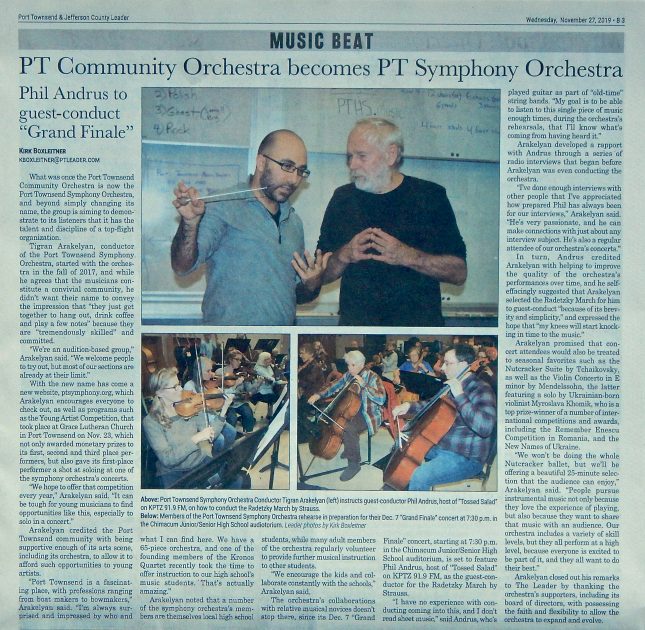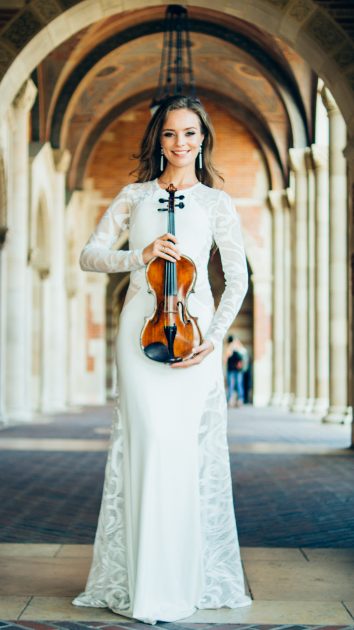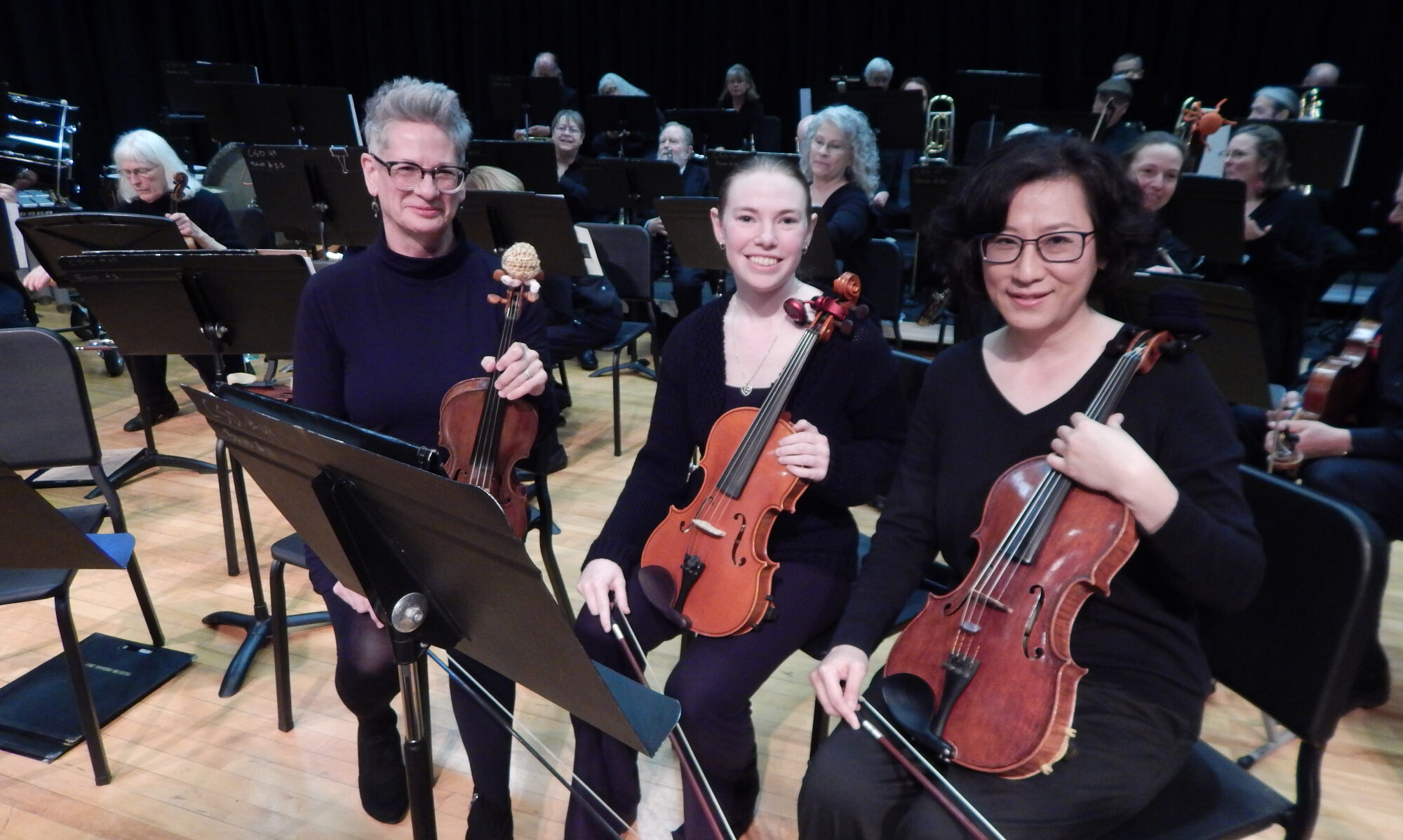
December 7 – The Grand Finale
Radetzky March by Strauss with Phil Andrus conducting.
Nutcracker Suite by Tchaikovsky.
Violin Concerto in E minor by Mendelssohn
with soloist Myroslava Khomik.
Chimacum High School Auditorium, 7:30 pm.
Click “Continue Reading” for access to the program notes by Miles Vokurka.
Radetzky
March
Johann Strauss Sr. (1804–1849)
It
is ironic that Johann Strauss Sr., known as “The Waltz Father”,
is also remembered for creating one of the world’s most famous
marches, a march which became a musical icon for the Austrian people.
The march was the result of a commission Strauss accepted to compose
a piece to be performed at a “victory festival” to celebrate the
exploits of the Austrian Army in a battle in Italy. The Commander of
the Austrian Forces was Bohemian-born Count Joseph Radetzky. Strauss
did not know Count Radetzky or have the slightest interest in
honoring him. He simply wrote the march just to honor his commission.
The March was so quickly written that on the afternoon prior to the
expected premiere, August 31, 1848, Strauss finally put pen to paper
and began writing. He used the melodies of two popular tunes, both in
3/4 waltz meter, rewritten into 2/4 march tempo. Originally scored
for piano four-hands, the piece was then quickly rewritten for
orchestra. Joachim Toeche-Mittler writes that the Radetzky is
“nothing like a Prussian march. It is light and charming, a true
child of Vienna — a typical Johann Strauss piece.”
When it was first performed for Austrian officers, they spontaneously clapped and stomped their feet during the opening chorus. That happy response continues to this day, quietly during the first time through the opening melody and then loudly (with a smile on your face) during the repeat of the tune. It has been a long-standing tradition of the Vienna Philharmonic to conclude every New Year’s concert with the Radetzky March.
Nutcracker Suite No. 1, Opus 71a
Pyotr Ilyich Tchaikovsky (1840–1893)
In 1891, the St. Petersburg Opera commissioned Tchaikovsky to compose two major works, an opera and a ballet. The opera, in one act, was Iolanthe, and the full-length ballet was The Nutcracker. Both were performed for the first time in December of 1892. As is so often the case, the composer felt that the opera was worth his efforts but that the ballet was unsuccessful. Time has completely changed the verdict on the value and the charm of these two compositions. The complete Nutcracker is now performed by countless ballet companies, primarily during the Christmas season, especially in North America. According to Wikipedia, major American ballet companies generate around forty percent of their annual ticket revenues from performances of The Nutcracker. Before the ballet’s December 1892 premiere, Tchaikovsky selected eight of the numbers from the ballet forming The Nutcracker Suite, intended for concert performance. The Suite was first performed, under the composer’s direction, in March 1892 at an assembly of the St. Petersburg branch of the Musical Society. The suite became instantly popular, with almost every number encored at its premiere, while the complete ballet did not begin to achieve its great popularity until after the George Balanchine staging became a hit in New York City in 1954. The suite’s sections are remarkable for their musical substance and Tchaikovsky’s masterly use of orchestral color. The march is brilliant in its composition, and one can imagine the characters taking their places in line for the dance which follows. The Arabian, Chinese and Mirlitons dances are beautifully descriptive of the music they characterize. The Dance of the Sugarplum Fairy, the piece that made the celesta famous, is still the most celebrated use of the instrument in all music. Waltz of the Flowers may be the most famous waltz ever written.

Violin
Concerto in E Minor
Felix Mendelssohn (1809–1847)
By
the time Felix Mendelssohn began to write this violin concerto, he
was already an accomplished performer and conductor and composer. We
see this as he takes a standard concerto structure and modifies it in
ways that influence music and audiences to this day. The piece was
written for and in collaboration with the concertmaster at the
Leipzig Orchestra, which Mendelssohn was conducting. Perhaps the most
striking and influential change Mendelssohn made was to link the
movements together. The first movement finishes with a rousing
cadence that would seem to be the end. However, because Mendelssohn,
as a performer, found applause between movements distracting, he had
each movement transition to the next. This is one reason that today,
audiences typically hold applause until the end of symphonies and
concerti.
The first movement is in sonata allegro form. Typically, the orchestra would present the opening theme. Mendelssohn, however, has the soloist enter almost immediately with the orchestra accompanying, providing a foundation for extensive virtuosic passages by the soloist. Even when the orchestra introduces the slower, second theme, the soloist soon takes it over and displays technical prowess while maintaining the appassionato feel. This leads into the development where the violin and orchestra alternate thematic material. Typically, the cadenza was improvised by the soloist near the end of the movement, however, Mendelssohn wrote out this cadenza and placed it earlier in the movement, between the development and the recapitulation. Other composers have employed these ideas since.
A single bassoon keeps playing after the first movement which leads into the slower andante movement. A contrast with the fireworks of the first movement, here the soloist brings passion to a simple melody and, during a second theme, displays technical mastery with extended sections playing double stops (two notes simultaneously). Following a return of the first theme, the second movement concludes with a quick fanfare before moving on to the third movement. If the first movement was dynamic and the second movement was emotional, the third movement is playful with Mendelssohn combining a recurring melody of a rondo with the variations of a sonata form. All of this leads to a final display of virtuosity at the conclusion of the piece.
Started in 1838, the music took five years to write and the initial performance of the concerto was by the Leipzig Orchestra in 1844 with their concertmaster David Ferdinand as soloist. Unfortunately, Mendelssohn was ill at the time and the debut was conducted by Mendelssohn’s assistant. Mendelssohn, himself, did conduct the concerto in 1845, again with Ferdinand as soloist.
